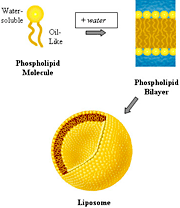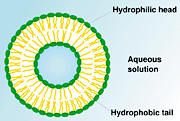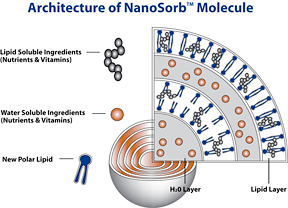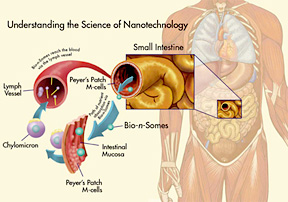The effort to understand the health benefits of plant foods ... is the characterization of their physiologically active constituents, the phytochemicals.
- Jean Mayer of the USDA Human Nutrition Research Center on Aging1
New nanotechnologies full of promise are being developed all the time. There is, however, some understandable concern with their use in our food and dietary supplements.2 Consumers are already worried about additives, pesticides, genetic modification, irradiation, antibiotics and, most recently, cloned meats.
It is important to know that Mother Nature has been using her own nanotechnology to enhance bioavailability for millennia and manufacturers have mimicked this to safely and effectively enhance bioavailability for decades. The purpose of this article is to make two things clear for the health professional:
- Proven, GRAS (generally recognized as safe by the FDA), "old-school" nanotechnologies have been used in foods and supplements for decades. These nanotechnologies rely on the same strategies and basic materials as Mother Nature.
- The use of such technologies can enhance bioavailability, efficacy and compliance of certain dietary supplements and functional-food drink mixes.
 Figure 1
Of course, all physiological processes, on some level, occur at the submicron, nanometer and even smaller picometer scale. An excellent example is digestion. The whole process of digestion involves making products smaller and smaller. Sometimes Mother Nature packages the digested nanosized nutrients into nanovesicles in order to make nutrients absorbable by the small intestine. Excellent examples of such natural digestive nanotechnology packaging vehicles are micelles and liposomes.
Figure 1
Of course, all physiological processes, on some level, occur at the submicron, nanometer and even smaller picometer scale. An excellent example is digestion. The whole process of digestion involves making products smaller and smaller. Sometimes Mother Nature packages the digested nanosized nutrients into nanovesicles in order to make nutrients absorbable by the small intestine. Excellent examples of such natural digestive nanotechnology packaging vehicles are micelles and liposomes.
Mother Nature's Problem
The problem is how to make an oil-soluble nutrient absorbable in the watery environs of the small intestine. Proteins and carbohydrates are more or less water-soluble. You might recall that once they are broken down via mechanical actions, acids, bicarbonates and enzymes, they are absorbed by the enterocytes of the microvilli of the mucosal layer of the small intestine either by passing between their tight junctions or via active transport. Fats, however, are absorbed differently. In order to break down fats, bile and lecithin are added to break up the fats and oils. But even these very small fat globules are not soluble in water.
The Nanotechnical Solution: Micelles and Liposomes
 Figure 2
Mother Nature's ingenious way of solving this conundrum is to create nanosized vesicles that are water-soluble on the outside and carry the fat-soluble nutrient on the inside. We call these nanovesicles micelles and liposomes.
Figure 2
Mother Nature's ingenious way of solving this conundrum is to create nanosized vesicles that are water-soluble on the outside and carry the fat-soluble nutrient on the inside. We call these nanovesicles micelles and liposomes.
Micelles. Micelle formation is essential for the emulsification and subsequent absorption of fat-soluble nutrients such as vitamins E, D and K, the carotenoids and omega-3 EFAs. It is the bile salts formed in the liver and secreted by the gallbladder that allow micelles of fatty acids to form. These lipid spheres, pictured below are a true natural nanotechnology, being smaller than 100 nanometers in size.
A typical micelle is a nanosized vesicular membrane made soluble in water by having a hydrophillic (water-loving) "head" facing the outside, while the hydrophobic (water-hating) "tails" surround the fat-soluble nutrient inside.3 Such micelle formation is known as emulsification, a process that allows a compound normally insoluble (in the solvent being used) to dissolve. Technically, this natural formation is referred to as a nanoemulsion.
Liposomes. Lipid spheres that contain an aqueous core are called liposomes, meaning literally "fat body." Liposomes are structurally different from micelles in that they have a bi-layer membrane (Figure 1). In the body, natural liposomes, like micelles, are composed of lecithin phospholipids. Though generally larger, they have the advantage of being able to carry both fat-soluble and water-soluble nutrients.4
 Figure 3
As depicted above (Figure 2), the fat-soluble ingredients are held in the white area between the hydrophobic tails, while water-soluble ingredients are held inside the blue area by the hydrophillic heads. The heads on the outside keep the liposome soluble in aqueous solution.
Figure 3
As depicted above (Figure 2), the fat-soluble ingredients are held in the white area between the hydrophobic tails, while water-soluble ingredients are held inside the blue area by the hydrophillic heads. The heads on the outside keep the liposome soluble in aqueous solution.
Liposomes also can be multi-laminar, like a ball within a ball within a ball (Figure 3). They carry a much bigger payload of both water-soluble and fat-soluble ingredients. Multi-laminar liposomes may reach up to perhaps 500 nm (0.5 micron) in size.
Once nanosized, fat nutrients are emulsified ("mycellized") or encapsulated in liposomes, they are absorbed by simple passive diffusion through the walls of the enterocytes of the small intestine. They can do this more easily than proteins or carbohydrates because the phospholipid membranes that make up the micelle and liposome are similar to the phospholipid membranes that make up the cell wall of the enterocytes.
Once inside the enterocytes, the micelles or liposomes are incorporated into chylomicrons. Together, these travel through the lymph system, bypassing the liver (portal circulation) into the subclavian vein. In the blood stream, these micelles and liposomes are digested by lipoprotein lipases derived from the capillary walls, releasing the nutrients. The liposome itself, usually made of principally lecithin, becomes a nutrient source of phospholipid choline (PC).5
Enhancing Absorption
"Antioxidants, which are found in many phytochemicals ... are biologically unstable, poorly soluble in water, and poorly distributed to target sites. ... We strongly advocate serious consideration of the bioavailability of dietary supplements ... to improve their bioavailability using delivery systems such as liposomal formulations."
�- Journal of Drug Targeting6
 Figure 4
Paying attention to bioavailability is vital. As pertains to this discussion, it is well-established that eating salad with fat-free dressings leads to essentially no absorption of carotenoids.7 There is simply not enough fat in the meal to provide stimulation of bile in order to promote micelle or liposome formation. Many greens drinks rich in lipid phytonutrient terpenes, such as carotenoids, chromanols (vitamins E and K, CoQ10) and/or limonoids, will not have enough fat to promote optimal liposome formation when taken with just water or juice. Therefore, it follows that those who take these green drinks likely are failing to absorb many of the fat-soluble phytonutrients and vitamins. People should drink their greens along with consuming a significant fat source simultaneously if they desire to maximize the absorption of fat-soluble phytonutrients such as carotenoids, lycopene or lutein, amines such as chlorophyll or vitamins K and E, to name just a few.
Figure 4
Paying attention to bioavailability is vital. As pertains to this discussion, it is well-established that eating salad with fat-free dressings leads to essentially no absorption of carotenoids.7 There is simply not enough fat in the meal to provide stimulation of bile in order to promote micelle or liposome formation. Many greens drinks rich in lipid phytonutrient terpenes, such as carotenoids, chromanols (vitamins E and K, CoQ10) and/or limonoids, will not have enough fat to promote optimal liposome formation when taken with just water or juice. Therefore, it follows that those who take these green drinks likely are failing to absorb many of the fat-soluble phytonutrients and vitamins. People should drink their greens along with consuming a significant fat source simultaneously if they desire to maximize the absorption of fat-soluble phytonutrients such as carotenoids, lycopene or lutein, amines such as chlorophyll or vitamins K and E, to name just a few.
Fortunately, pre-emulsification by micellization or pre-encapsulation in lecithin-based liposomes are nanosizing technologies that have been used safely for decades to make fat-soluble nutrients more bioavailable, whether or not they are taken with a fatty meal. This anywhere/anytime convenience greatly increases compliance and results.
Multi-Laminar Liposomes: An Extra Bonus
Of course even non-lipophillic ingredients can be hard to absorb, as the following quotes demonstrate:
- "The low solubility of free ellagic acid (a phytonutrient of the organic acid class derived from fruits and nuts, especially raspberries and wild tart cherries) is thought to be due to its low solubility in water."8
- "The bioavailability of quercetin-3-rutinoside is 17 percent"9
- "Bioavailability differs greatly from one polyphenol to another"10
- "In general ... epicatechins (polyphenols from green tea) ... had low bioavailability."11
Multi-laminar liposomes can trap some portion of the above ingredients in their water-loving layers, making them more bioavailable. This also is a viable strategy for B12, whose absorption can be compromised by such common diseases of aging as atrophic gastritis or certain common pharmaceuticals.
Even more interesting is the use of liposomes to protect delicate enzymes or peptides like glutathione (a tripeptide) or very small peptide chains such as proline-rich polypeptides (PRP) from colostrum, from being destroyed by the acids and enzymes in the digestive process.12
Mother Knows Best
New exciting nanotechnologies already are here and many more are coming. Their potential benefit has been acknowledged. Micelles and liposomes, both being true nanotechnologies, have been safely used in cosmeceuticals, pharmaceuticals and dietary supplements for decades. It is just that "back in the day," no one used the "nano" terminology.
By demonstrating such a safe history, micelles and liposomes generally are recognized as safe by the FDA. Nano-liposomes and nano-micelles can safely enhance the bioavailability, clinical efficacy and compliance of a wide variety of dietary supplements and functional-food drink mixes.
References
- Mayer, J, Functional Foods for Health Program. Boston: USDA Human Nutrition Research Center on Aging, Tufts University.
- Montague-Jones G. "Commission Develops Code of Conduct on Nanotechnology." www.nutraingredients-usa.com/news/ ng.asp?n=83199-nanotechnology-flavour-packaging.
- Seddon JM, Templer RH. Polymorphism of Lipid-Water Systems. In: Handbook of Biological Physics, Vol. 1, Lipowsky R, Sackmann E, Eds. New York: Elsevier Science, 1995.
- Torchilin VP. Multifunctional nanocarriers. Adv Drug Deliv Rev, 2006 Dec 1;58(14):1532-55.
- Keller B. Liposomes. www.biopharmasci.com/downloads/nanosorb.ppt.
- Shoji Y, Nakashima H. Nutraceutics and delivery systems. J Drug Target, 2004;12(6):385-91.
- Brown MJ, Ferruzzi MG, Nguyen ML, et al. Carotenoid bioavailability is higher from salads ingested with full-fat than with fat-reduced salad dressings as measured with electrochemical detection. Am J Clin Nutr, 2004 Aug;80(2):396-403.
- Seeram NP, Lee R, Heber D. Bioavailability of ellagic acid in human plasma after consumption of ellagitannins from pomegranate (Punica granatum L.) juice. Clin Chim Acta, 2004 Oct;348(1-2):63-8.
- Olthof MR, Hollman PC, Vree TB, Katan MB. Bioavailabilities of quercetin-3-glucoside and quercetin-4'-glucoside do not differ in humans. J Nutr, 2000 May;130(5):1200-3.
- Manach C, Williamson G, Morand C, et al. Bioavailability and bioefficacy of polyphenols in humans. Review of 97 bioavailability studies. Am J Clin Nutr, 2005 Jan;81(1 Suppl):230S-42S.
- Xu JZ, Yeung SY, Chang Q, et al. Comparison of antioxidant activity and bioavailability of tea epicatechins with their epimers. Br J Nutr, 2004 Jun;91(6):873-81.
- Chaize B, Colletier JP, Winterhalter M, Fournier D. Encapsulation of enzymes in liposomes: high encapsulation efficiency and control of substrate permeability. Artif Cells Blood Substit Immobil Biotechnol, 2004;32(1):67-75.
Click here for previous articles by John Maher, DC, DCBCN, BCIM.





